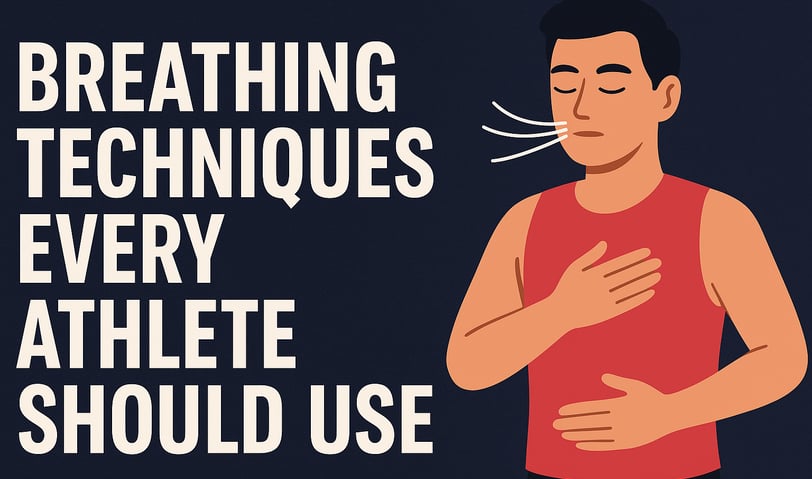Breathing Techniques Every Athlete Should Use for Endurance, Focus & Recovery
Boost your performance with 3 essential breathing techniques every athlete should master—nasal breathing, box breathing, and diaphragmatic control. Learn how to improve endurance, reduce anxiety, and sharpen mental focus with daily breathwork.
5/21/20253 min read


Breathing Techniques Every Athlete Should Use to Improve Endurance & Focus
Breathing is the foundation of athletic performance—and yet it’s often overlooked. When we breathe inefficiently, we limit our stamina, spike our anxiety, and cloud our focus. But with three simple techniques—nasal breathing, box breathing, and diaphragmatic control—you can unlock real sport gains: better endurance, calmer nerves, and sharper mental clarity. Here’s how.
1. Nasal Breathing: Quiet, Efficient, Essential
What It Is:
Breathing through your nose filters, warms, and regulates airflow. You naturally slow down your breath and increase nitric oxide—key for oxygen efficiency.
How to Do It:
Keep both in and out breaths going through the nose. If that’s tough at rest, try nasal strips or dilators to open up your airway and ease the transition.
Why It Works for Athletes:
Nasal breathing reduces hyperventilation and stabilizes your heart rate. Athletes report greater endurance, smoother performance, and less fatigueWikipediaTime.
🛠️ Product we recommend : AIRMAX Nasal Dilator
What It Is: A natural, comfortable nasal dilator to boost airflow, reduce resistance, and support easier nasal breathing AmazonAmazon.
Why Try It: Ideal for athletes who struggle to breathe through their nose during training or recovery.
How to Use It: Place before workouts, sleep, or meditation—daily use helps your body relearn nasal breathing patterns.
2. Box Breathing: Calm Under Pressure
What It Is:
A rhythmic breathing pattern—inhale, hold, exhale, hold—each for the same count. Commonly used by Navy SEALs, elite coaches, and pro athletes.
How to Do It:
Inhale for 4 seconds
Hold for 4 seconds
Exhale for 4 seconds
Hold for 4 seconds
Repeat for 5–10 cycles.
Why It Works:
Balances sympathetic and parasympathetic nervous systems, lowers cortisol, and centers your mind. Research shows box breathing reduces anxiety, improves heart-rate variability, and enhances mental focus—perfect for performance or recovery zones.
3. Diaphragmatic (Belly) Breathing: Power From the Core
What It Is:
Breathing deep into your belly—engaging the diaphragm—rather than shallow chest breaths.
How to Do It:
Lie on your back or sit upright
Place one hand on your chest, one on your belly
Inhale slowly through your nose, sending your belly up
Exhale fully, drawing your belly back in
Aim for 6–8 slow breaths per minute for 2–3 minutes.
Why It Works:
Improves lung capacity, oxygen exchange, and relaxation. Athletes experience reduced muscle tension, lower heart rates, and improved posture during heavy lifts or endurance sessions.
Building a Daily Breathing Practice
Before Training: 2 minutes nasal breathing to prime your breath and calm nerves.
During Breaks or Between Sets: 2–3 rounds of box breathing to reset focus and reduce cortisol.
After Training or at Night: 3–5 minutes of diaphragmatic breathing—to speed recovery and enhance sleep.
Over time, this layered approach helps your body default to efficient breathing—even under pressure.
🛠️ Product we recommend : THE BREATHER – Respiratory Muscle Training Device
What It Is: A handheld resistance breathing trainer with an app to guide inhalation and exhalation workouts AmazonAmazon.
Why Try It: Strengthens diaphragm and intercostal muscles—directly improving your ability to breathe deeply and maintain endurance.
How to Use It: Incorporate 5–10 minutes sessions daily, adjusting resistance as you progress, to build breathing stamina and control.
Real Sport Outcomes You’ll Feel
Reduced Anxiety & Better Focus
Box breathing and diaphragmatic control activate your parasympathetic system. Athletes consistently report calmer race prep, clearer mental flow, and more consistent performance.Improved Stamina & Oxygen Efficiency
Nasal breathing and breathing trainers help you use oxygen more efficiently. That translates to lower heart rates at tempo effort, longer efforts before fatigue, and faster recovery times.Sharper Mental Clarity & Decision-making
Controlled breathing reduces stress hormones and enhances prefrontal cortex function. Whether it’s nailing a sprint finish or making a clutch play, you’ll stay sharper under pressure.
🛠️ Product we recommend : Mindsight “Breathing Buddha” Guided Biolight
What It Is: A visual breathing coach—LED light pulses guide your inhale and exhale to the proper rhythm (like 4‑7‑8 or 5‑5‑5 breathing) AmazonAmazon.
Why Try It: Ideal for box breathing practice or calming before bed/training. No timer needed—just match your breath to the light pulses.
How to Use It: Place on a desk or nightstand and follow its natural glow—great for stress relief and mental resets throughout the day.
How Fast Will You See Results?
Within Days: You’ll notice calmer breathing, less tension before events, and better recovery during cool-downs.
In 2–3 Weeks: Stamina increases—aerobic training feels smoother, and fatigue resistance gets better.
By Month 2: Mental clarity improves, stress responses lower, and your body naturally favors nasal breathing—even when fatigued.
Final Thoughts
Breathing is your most powerful yet overlooked performance tool. With just three techniques—nasal breathing, box breathing, and diaphragmatic control—you’re rewiring your stress response, stamina, and mental clarity. Add in smart tools to support those habits, and you're optimizing your breath for peak performance.
Let me know if you want a quick infographic, printable breathing schedule, or video walk-throughs of each technique!
FITNESS
Nutrition
WellnesS
info@movebetterco.com
© 2025. All rights reserved | Privacy Policy | Terms & Conditions